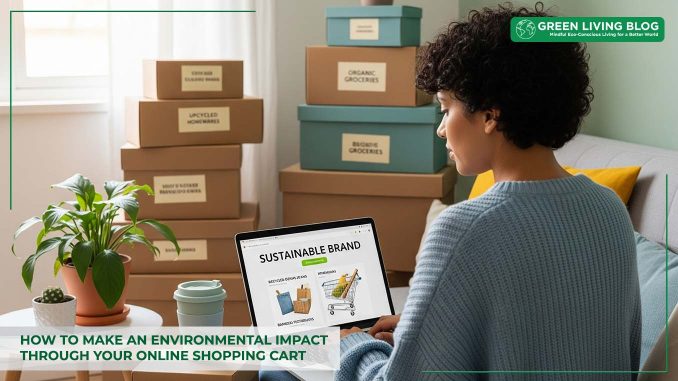
Living sustainably in this era is hard. The most unsuspecting actions can significantly contribute to your carbon footprint.
Add that to the pressure to stay on top of the latest trends, the influence of pop culture and social media, and reducing harmful consumption.
It can feel impossible at times. But it’s not impossible.
There are tiny adjustments you can make, especially when online shopping, to live just a little more sustainably.
5 Small Changes to Make Today
Next time you’re browsing your favourite online shop, take a pause. These tips can help you be a more sustainable shopper.
1. Internalise the Concept of Slow Fashion

Slow fashion is a lifestyle movement that aims to counteract the adverse effects of the fast fashion industry. Where fast fashion capitalises on the consumer’s love for the latest trends, moods, and viral products. In contrast, slow fashion emphasises items designed to endure beyond trends—pieces that are both timeless in style and built to last.
Slow fashion retailers are typically artisans who work with smaller teams and create more unique items. While these pieces may be more expensive, their price per use is usually lower. And slow fashion items, often purchased with considerable forethought, are less likely to end up in the rubbish.
2. Resist Impulse Purchases
Modern-day marketing practices use data and browsing habits to get to know customers. They also make more informed decisions about how to best advertise products. For better or for worse, this includes targeting users with impressive precision, including when they are most likely to purchase something by impulse.
Switching to slow fashion purchasing practices can help. Another practical way to avoid getting caught in the cycle of buying on impulse—which can also lead to unnecessary returns and affect your online shopping carbon footprint—is to reduce the likelihood of being targeted in this way.
Services like Incogni can help reduce your data metrics being shared around the web and used in this way.
3. Make Important Purchases in One Shopping Cart

The cost of shipping when you make online purchases is not just monetary. Receiving a single parcel at your home includes the environmental cost of CO2 emissions. While many companies in the UK are committed to reducing per-parcel delivery impact, every trip the delivery van has to make to your exact location has a cost. This environmental impact is especially significant if you’re ordering from abroad and shipping includes air transit.
If you know you will be shopping online for a product, think ahead to what other things you may be ordering soon. That way, you can combine multiple products into one shipping instance, subtly cutting down on the amount of emissions from your online shopping.
4. Reuse and Recycle Packaging
Plastic packaging is a well-known offender of unsustainability, but many companies continue to use plastic to protect products in transit. While cardboard is marginally better, the process of producing cardboard boxes still has a significant impact on the environment.
Some retailers offer options to opt out of certain types of packaging, but it’s not common. How can you counteract this? By reusing or recycling product packaging in various ways. Plastic bags can be used as rubbish bags. Cardboard boxes can be reused for creative projects like art or turned into complex forts and rocket ships for children. In the worst-case scenario, cardboard boxes can be saved and donated to friends or family members who will inevitably need to move one day.
If you’re not a fan of reusing packaging materials or don’t have space to keep them, at the very least, make sure they end up in the right bin.
5. Hold Companies Accountable

Unless a product is 100% unique, you can likely find multiple brands or companies offering a variation of what you’re looking for. A few minutes of research will let you know if the company you are considering purchasing from has decent sustainability policies. Speak with your wallet and opt for brands that prioritise sustainability. If your go-to brand doesn’t have good eco-friendly products and practices, don’t be afraid to let them know you expect better from them in the future.
Collective Effort
Making sustainable choices when online shopping, even as small as they often seem, may feel like only a small drop in the bucket towards living in a more sustainable world. If every consumer, little by little, starts changing their habits, the impact can be much more widespread than it initially feels. No one is perfect, and an impulse purchase here and there isn’t the end of the world. But by slowly changing your habits and encouraging your friends and family to do the same, you can make a bigger impact than you think.
![]()
Author Profile

- Eco Warrior by day, Eco Blogger by night trying to get the eco balance right.
Latest entries
 Green GuidesNovember 3, 2025The Beginner’s Guide to Making Your Own Nontoxic Candles at Home
Green GuidesNovember 3, 2025The Beginner’s Guide to Making Your Own Nontoxic Candles at Home Green Home GuidesOctober 14, 2025What are Eco-Friendly Tissue Options for Modern UK Homes?
Green Home GuidesOctober 14, 2025What are Eco-Friendly Tissue Options for Modern UK Homes? Best practicesSeptember 17, 20253 Ways Young Families Can Commit to Sustainable Living
Best practicesSeptember 17, 20253 Ways Young Families Can Commit to Sustainable Living EnvironmentSeptember 9, 2025Eco-friendly Gardening on a Budget: 6 Sustainable Choices that make a Difference
EnvironmentSeptember 9, 2025Eco-friendly Gardening on a Budget: 6 Sustainable Choices that make a Difference





Leave a Reply
You must be logged in to post a comment.